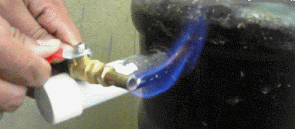Bio Gas plant from Kitchen waste
Literature Study : Bio Gas from Kitchen waste
The Principle: Biomass in any form is ideal for the Biomethanation concept, which is the central idea of the Biogas plants. Based on thermophilic microorganisms and microbial processes develop the design of the biogas plant. The plant is completely gravity based.
Brief process description: The segregated wet garbage (food waste) is brought to the plant site in bins and containers. It is loaded on a sorting platform and residual plastic, metal; glass and other non-biodegradable items are further segregated. The waste is loaded into a Waste Crusher along with water, which is mounted on the platform. The food waste slurry mixed with hot water is directly charged into the Primary digester.
This digester serves mainly as hydrolysis cum acidification tank for the treatment of suspended solids. For breaking slag compressed air is used for agitation of slurry. Compressed air will also help in increasing aeration since bacteria involved in this tank are aerobic in nature. The tank is designed in such a way that after the system reaches equilibrium in initial 4-5 days, the fresh slurry entering the tank will displace equal amount of digested matter from top into the main digester tank.
Main digester tank serves as a methane fermentation tank and BOD reduction takes place here. The treated overflow from this digester is connected to the manure pits. This manure can be supplied to farmers at the rate of 4-5 Rs. per Kg. Alternatively municipal gardens and local gardens can be assured of regular manure from this biogas plant.
The biogas is collected in a dome (Gas holder) is a drum like structure, fabricated either of mild steel sheets or fibreglass reinforced plastic (FRP). It fits like a cap on the mouth of digester where it is submerged in the water and rests in the ledge, constructed inside the digester for this purpose. The drum collects gas, which is produced from the slurry inside the digester as it gets decomposed and rises upward, being lighter than air. 1" GI piping will be provided up to a distance of 50 m from the Biogas plant. Biogas burners will be provided. The biogas can be used for cooking, heating and power generation purpose.
Cost details, saving and payback period from a biogas plant: The cost details and the savings envisaged from the plant are given in the following table. The life of the plant could be 20-30 years and payback period is 4-5 years.
Literature Study : Bio Gas from Kitchen waste
The Principle: Biomass in any form is ideal for the Biomethanation concept, which is the central idea of the Biogas plants. Based on thermophilic microorganisms and microbial processes develop the design of the biogas plant. The plant is completely gravity based.
Brief process description: The segregated wet garbage (food waste) is brought to the plant site in bins and containers. It is loaded on a sorting platform and residual plastic, metal; glass and other non-biodegradable items are further segregated. The waste is loaded into a Waste Crusher along with water, which is mounted on the platform. The food waste slurry mixed with hot water is directly charged into the Primary digester.
This digester serves mainly as hydrolysis cum acidification tank for the treatment of suspended solids. For breaking slag compressed air is used for agitation of slurry. Compressed air will also help in increasing aeration since bacteria involved in this tank are aerobic in nature. The tank is designed in such a way that after the system reaches equilibrium in initial 4-5 days, the fresh slurry entering the tank will displace equal amount of digested matter from top into the main digester tank.
Main digester tank serves as a methane fermentation tank and BOD reduction takes place here. The treated overflow from this digester is connected to the manure pits. This manure can be supplied to farmers at the rate of 4-5 Rs. per Kg. Alternatively municipal gardens and local gardens can be assured of regular manure from this biogas plant.
The biogas is collected in a dome (Gas holder) is a drum like structure, fabricated either of mild steel sheets or fibreglass reinforced plastic (FRP). It fits like a cap on the mouth of digester where it is submerged in the water and rests in the ledge, constructed inside the digester for this purpose. The drum collects gas, which is produced from the slurry inside the digester as it gets decomposed and rises upward, being lighter than air. 1" GI piping will be provided up to a distance of 50 m from the Biogas plant. Biogas burners will be provided. The biogas can be used for cooking, heating and power generation purpose.
Cost details, saving and payback period from a biogas plant: The cost details and the savings envisaged from the plant are given in the following table. The life of the plant could be 20-30 years and payback period is 4-5 years.














